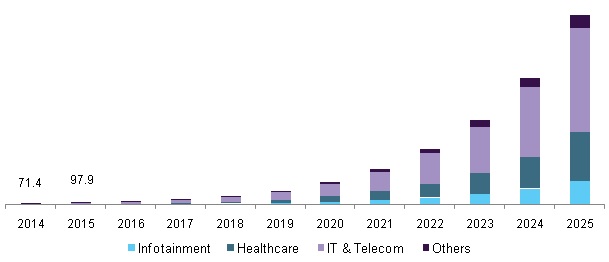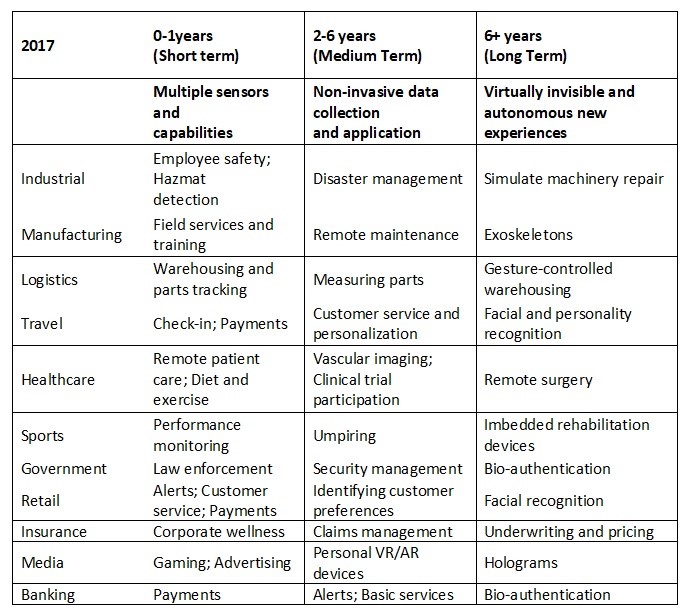Article Summary:
The recent advancement in wearable technology has unlocked the potential opportunities for the wearables devices across different sectors such as healthcare, automotive, logistics, field service, retail, construction, and others. This technology is helping organizations to make their workplaces more efficient and safer. Accordingly, many enterprises are taking the initiative and collaborating with wearable tech solution providers to leverage the technology and develop vertical-specific solutions.
*************************************************************************
Over the last few years, the enterprise wearable market has witnessed substantial growth, owing to the extensive adoption of enterprise wearable in industries such as Healthcare, IT & Telecom and Aerospace. According to Grand View Research, the enterprise wearable market is expected to reach $22.30 billion by 2025.
Extensive research and development activities and the level of innovation in wearable technologies will lead to fundamental changes in the way enterprises carry out their day-to-day tasks. However, the full potential of wearable technology has not yet been recognized.
The use of wearable technology means that a variety of businesses are now adding value within their organizations; issues are now being overcome, which were previously difficult to resolve. Wearables have changed enterprises by increasing safety, quality, efficiency, and by reducing costs. As the technology and its adoption develop, body-worn sensors, head mounted displays, and exoskeletons will increase employee productivity and safety; whilst eyewear devices and adjustable clothing will improve employee and user experience.
DHL completed its pilot project, “Vision Picking” which utilizes the AR capabilities of smart glasses to view product location, replacing paper and handheld scanners. Their worldwide trials have revealed an average productivity improvement of 15% coupled with higher accuracy rates, even when allowing for on-boarding and training time.
The healthcare sector is the most lucrative market currently for the enterprise wearable. Many companies are doing extensive research and development in the health monitoring segment, which has resulted in the development of comfortable, portable, highly accurate and reliable devices to measure & monitor crucial human body signals. According to Grandview Research, the enterprise wearable market for healthcare applications is expected to grow fastest over the forecast period.
Over the next decade and more, demand for medical devices with specific diagnostic capabilities will increase exponentially. This means that the clinical monitoring segment will provide a huge opportunity to those market players developing applications for the sector. Many companies are already collaborating with medical industry players in order to manufacture medical wearable devices that are appropriate and relevant.
U.S. Enterprise Wearable Market, By Application, 2014 - 2025 (USD Million)
Source: Grand View Research

Significant market trends driving large scale adoption of enterprise wearable:
- Development of wearable design specific to enterprise requirement:
Initially, wearables were mostly designed for consumer use to monitor health, rather than for enterprise use. These devices had short-range transmission, poor battery life and were vulnerable to malware attacks. However, increased adoption of wearable technology in an enterprise scenario, created the necessity for devices with enhanced battery life, interoperability, aesthetic appeal, improved data security as well as improved range for communication and data transmission.
- Customized software application specific to enterprise need:
In order to address specific enterprise requirements, wearable software providers need to develop customized applications. The operating system and the application need to be updated regularly to guarantee that data is properly processed. For instance, the launch of Knox Tizen SDK on the Samsung Gear S3 which makes wearable app customization easier. Moreover, it is more easily accessible for app developers and enterprises, allowing them to build software applications for specific business purposes.
- Technology Development:
IoT comprises the breakthrough technologies in which physical objects such as smart phone, wearable, vehicle and others connect to a network in order to exchange and collect data. IoT technology is helping organizations reduce costs through process improvement, asset utilization and increasing productivity.
The integration of wearable and IoT technologies has empowered the connection between businesses and employees, providing them with the tools to make workplaces safer and more efficient. The increasing demand for IoT technology across different sectors will also help drive the enterprise wearable market. The combination of IoT and wearable technology will aid the development and deployment of next generation, value added services by utilizing user-centric data.
- Mobility:
Wearable technology is further helping to ease the barrier between the man-machine interfaces. With the use of wearable devices for work, enterprises can now increase employee mobility and workplace productivity, particularly in those industries with challenging work atmospheres, such as transportation, mining, healthcare, hospitality and construction.
Wearable devices, such as smart watches, can enable simple, real-time, hands-free communication among employees in the field or for those who need to communicate with co-workers at different locations. This is particularly useful in the energy sector, for example, where those in the field, work in some of the harshest environments. In this setting, wearable devices that facilitate hands-free communication can be a safer alternative for them.
- Data Analytics:
The proliferation of mobile devices and penetration of broadband technology have brought a major shift in businesses. Owing to this, enterprises are flooded with a large quantities of data and wearable devices will further contribute to the enterprise data. The exponential growth of wearable data has created the need for storing, managing and analyzing data. In this scenario, analytics have a primary role to play in extracting meaningful insights to benefit enterprises. For instance, wearable devices with built-in analytical functions allow doctors to remotely monitor critical parameters of their patients’ health. This allows patients to be mobile rather than being confined to hospital beds and has the additional benefit of producing significant, tangible cost-savings.
- Data Security:
The growing adoption of wearables can accelerate data generation in an organization as well as the concerns related to its rational usage. The present ecosystem is mostly fragmented, so the platform, which can substantiate its strength and can address privacy concerns will benefit from an increase in adoption rates. The use of a strong platform will mean that enterprises can allow employee access, while also facilitating storage and security of the data. Such platforms allow managers to control employee access to devices. Additionally, the enterprise needs to expand their BYOD definition to encompass smart objects and wearables.
Wearable platforms diverge from other device (laptops, tablets, smartphone and other) platforms, which require particular applications that can support many different wearables. However, most of the current wearables platforms can be backed by enterprise mobility management (EMM) solutions such as mobile application, mobile device management and mobile content management, to ensure security at different locations. For instance, wearables can be used to authenticate the identity of the user in areas such as at the bank or airport.
Let's take a look at some of the use cases for enterprise wearables that will adopted by the enterprise over a period, based on technology advancement: (Page 25)

Key take aways:
About the Author:

Pooja Kamble is a Senior Research Associate at Grand View Research. She holds a bachelor degree in Electronics and Telecommunication Engineering and MBA in Operations. She has keen interest in studying changing trends of innovative technologies.
Contact Details:
Email: info-apac@grandviewresearch.com
Phone: 1-415-349-0058
LinkedIn: https://www.linkedin.com/company/grand-view-research/
Website: https://www.grandviewresearch.com/







